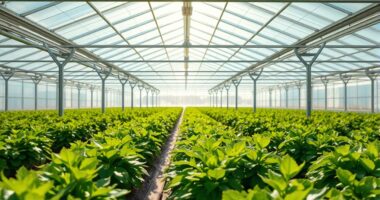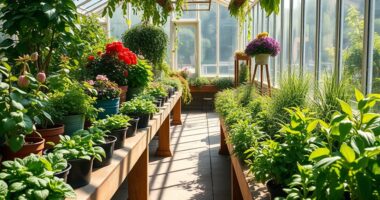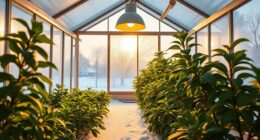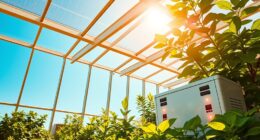When choosing a greenhouse, consider your gardening needs. Freestanding greenhouses offer flexibility, while gothic arch designs maximize durability and light. A-frame styles provide excellent ventilation, and hoop houses give cost-effective solutions. For early planting, cold frames protect tender plants. Materials matter too—glass maximizes light, but polycarbonate offers better insulation. If you have unique cultivation goals, specialty greenhouses can help. Each type serves different purposes, so explore your options to find the perfect fit for you.
Key Takeaways
- Consider your space and desired crop types when choosing a greenhouse, as freestanding options offer versatility for various plants.
- For optimal light and air circulation, gothic arch greenhouses are ideal for taller crops and harsh weather conditions.
- A-frame greenhouses provide excellent ventilation and are easy to construct, making them suitable for beginners.
- Hoop houses are budget-friendly solutions that extend the growing season with passive solar heating; perfect for warmer climates.
- If you seek a controlled environment for specialized crops, consider hydroponics or light deprivation greenhouses for maximum efficiency.
Understanding Freestanding Greenhouses
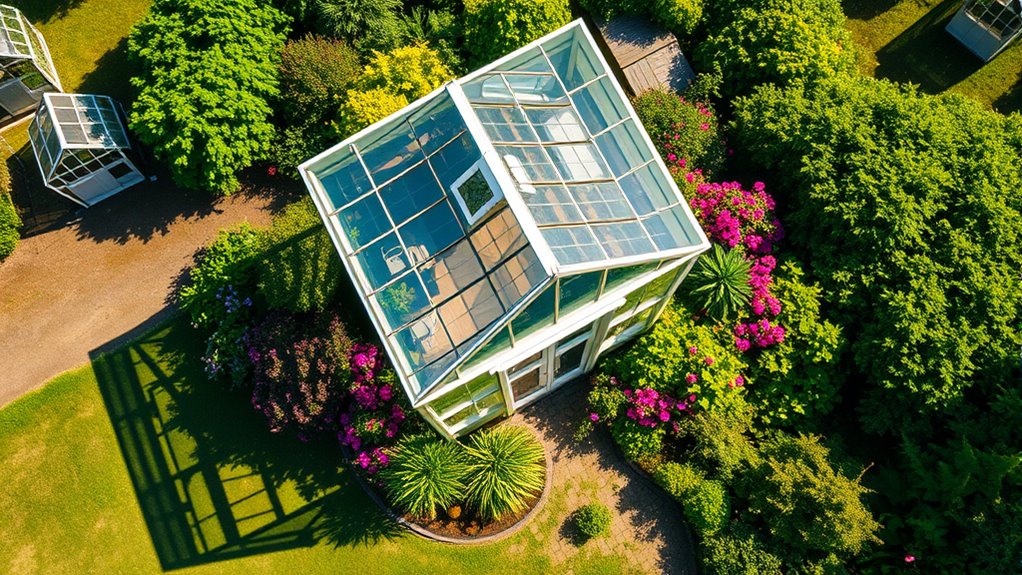
Freestanding greenhouses offer a versatile solution for growers seeking independence and flexibility in their gardening efforts.
With various roof shapes like quonset, gothic, or gable, you can choose what best fits your space and light requirements. Gabled structures can span up to 60 feet wide, while gothic and quonset styles typically range from 12 to 34 feet.
Choose from various roof shapes like quonset, gothic, or gable to best suit your gardening needs.
You’ll find that these greenhouses can be built to any length, depending on your glazing material. The frames, made from aluminum, wood, or PVC, provide options for durability and cost.
Plus, freestanding greenhouses allow light to pour in from all sides, creating an ideal environment for plant growth. Their design is perfect for maintaining different growing conditions independently.
Exploring Gothic Arch Greenhouses
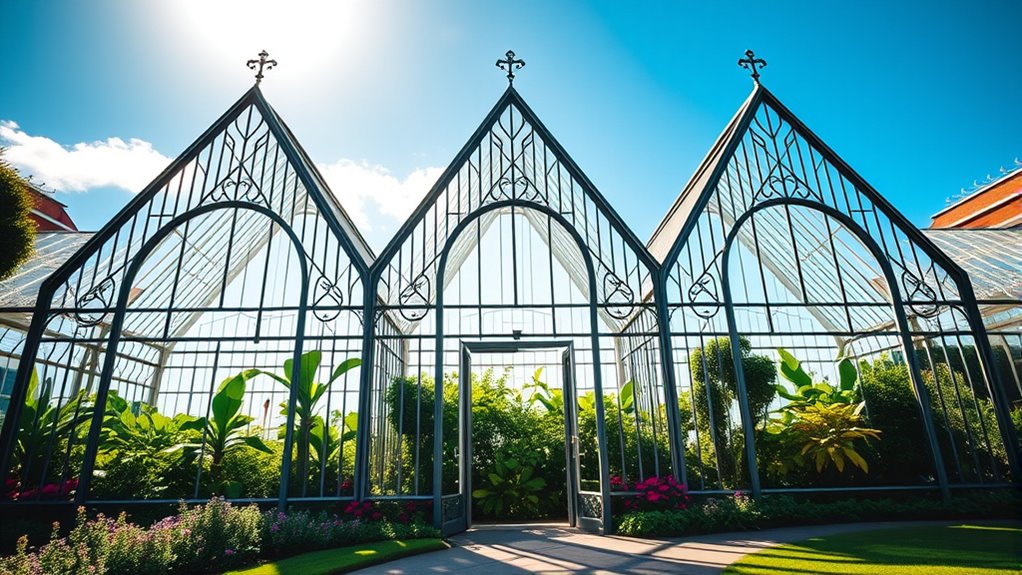
Gothic arch greenhouses offer unique structural benefits that make them a popular choice for gardeners.
Their curved design not only enhances durability but also creates ideal growing conditions by maximizing light and air circulation.
You’ll appreciate how these features work together to support your plants throughout the year.
Structural Benefits Overview
When you’re considering greenhouse designs, the Gothic arch style stands out for its impressive structural benefits. Its half-teardrop roof shape makes it exceptionally durable, able to withstand strong winds and heavy snowfall.
You’ll find that the arched design eliminates the need for structural trusses, reducing both material use and costs. Plus, you can install it at various heights, offering flexibility for your space.
With increased overhead space, it’s perfect for growing taller crops like tomatoes and cucumbers. The unique curve not only enhances aesthetics but also promotes effective snow and rain management, ensuring your greenhouse remains robust in adverse weather conditions.
Ideal Growing Conditions
The impressive structural benefits of Gothic arch greenhouses directly contribute to creating perfect growing conditions for a variety of plants.
You’ll find that they maintain ideal temperatures between 80-85°F, perfect for most species. The curved design guarantees uniform light distribution, promoting healthy growth.
With effective ventilation, you can manage humidity levels, reducing the risk of mold and diseases. These greenhouses adapt well to different climates, shielding your plants from extreme weather.
Year-round, you can cultivate diverse crops, from hearty winter vegetables like broccoli to delicate tropical plants.
Whether you’re growing herbs, flowers, or vegetables, Gothic arch greenhouses provide a nurturing environment that enhances your gardening experience.
The Benefits of A-Frame Greenhouses
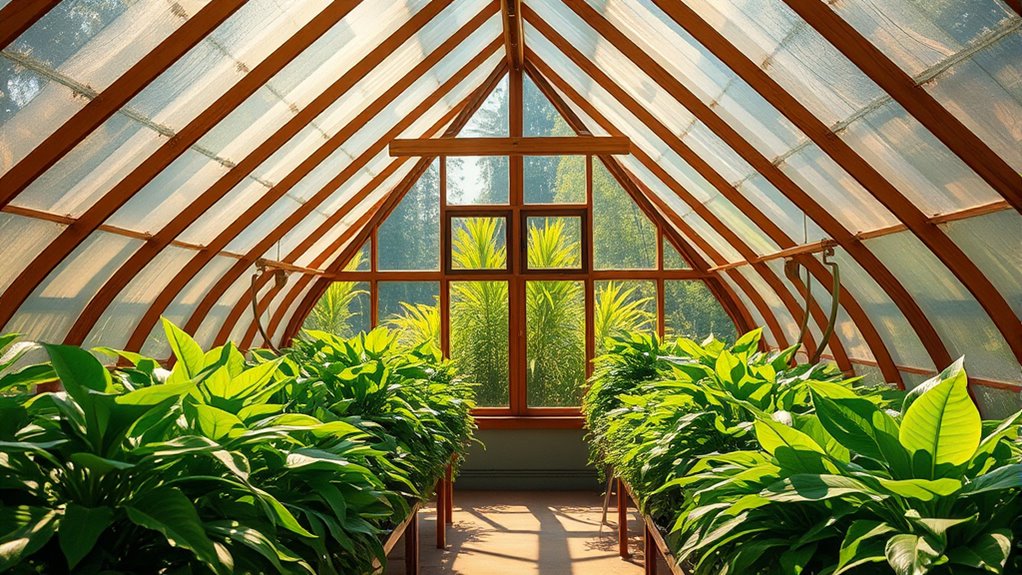
A-Frame greenhouses offer excellent ventilation, making it easier for air to circulate and keep your plants healthy.
With their design maximizing sunlight exposure, your plants can soak up all the light they need to thrive.
Plus, their simple construction process means you can have your greenhouse up and running in no time.
Excellent Ventilation Design
While effective ventilation is essential for any greenhouse, A-Frame designs stand out due to their unique structural advantages. The steeply sloped roof enhances natural ventilation, allowing wind-driven airflow to efficiently cool the space.
With proper vent sizing—both roof and sidewall—you can achieve ideal air exchange, vital for maintaining healthy plants. The pressure differences from wind and temperature gradients work effectively in this design, making it an excellent choice for beginners.
Additionally, A-Frame greenhouses are cost-effective and stable, especially when properly anchored. You’ll find that they also accommodate seasonal ventilation adjustments, ensuring your plants thrive in varying weather conditions.
Ample Sunlight Exposure
With effective ventilation already covered, it’s time to explore how A-Frame greenhouses excel in providing ample sunlight exposure.
Their triangular structure allows sunlight to pour in from multiple angles, making it easier for your plants to thrive. The steep sloping roofs enhance this effect, ensuring sunlight penetrates deep into the greenhouse, even during winter months.
This design supports the growth of sun-loving plants like tomatoes and peppers, promoting healthy photosynthesis. You’ll also enjoy year-round gardening, thanks to the consistent light availability.
Plus, the natural diffusion of light helps regulate temperature, creating ideal conditions for a wider variety of crops.
In short, an A-Frame greenhouse is your go-to for maximizing sunlight and boosting plant growth.
Easy Construction Process
Building an A-Frame greenhouse is an accessible project for gardeners of all skill levels. Its simple two-legged design with cross beams makes assembly straightforward, requiring minimal construction experience.
The triangular shape provides natural stability, reducing the need for extra supports. You can choose from various materials like lumber, aluminum, or PVC, making it cost-effective and versatile.
With low initial costs and long-term savings on maintenance, this design offers durability and adaptability for different climates. Additionally, A-Frame greenhouses can be tailored to fit various climates and conditions, ensuring that your plants thrive no matter where you live.
Plus, A-Frame greenhouses allow for easy expansion and customization, letting you create the perfect space for your plants. You’ll enjoy a sense of accomplishment as you build a structure that’s both functional and aesthetically pleasing, fitting seamlessly into your landscape.
Cost-Effective Solutions With Hoop Houses

Hoop houses offer an affordable way to extend your growing season and protect your crops without breaking the bank.
Constructed with PVC piping or metal hoops and covered in polyethylene plastic, they’re much more cost-effective than traditional greenhouses. You can set up a hoop house easily with just a few basic tools and materials.
They typically last 3 to 5 years, allowing you to grow a variety of crops like vegetables, fruits, and herbs. With passive solar heating, hoop houses provide a warm environment while also shielding plants from harsh weather.
Plus, their roll-up sidewalls offer natural ventilation. The combination of affordability and versatility makes hoop houses an excellent choice for small-scale growers and hobbyists. Additionally, hoop houses are a great example of DIY greenhouse solutions, promoting sustainable gardening practices.
Utilizing Coldframes for Plant Protection
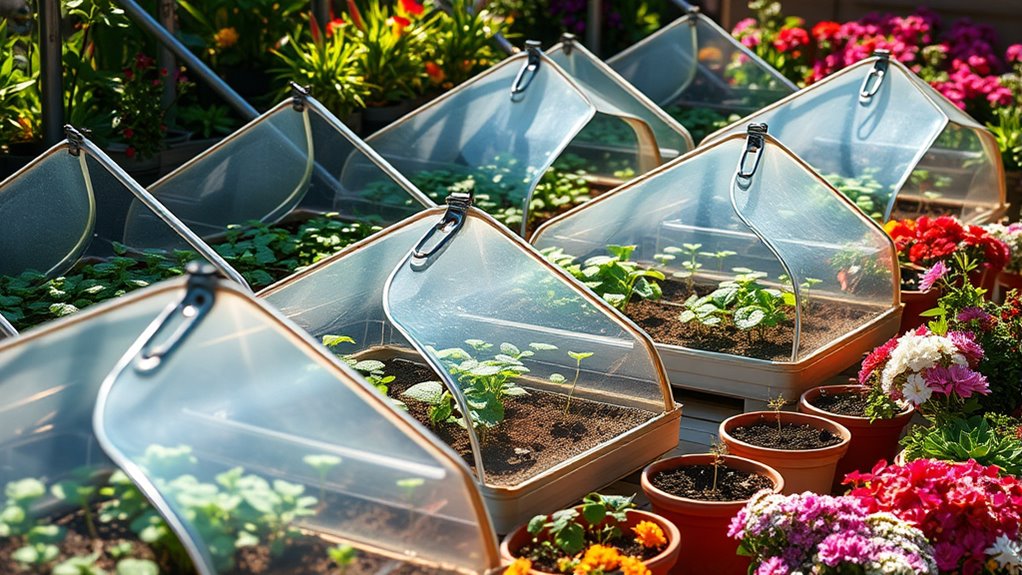
While you might think that protecting your plants from unpredictable weather is a challenge, using cold frames can simplify the process considerably.
These structures extend your growing season, allowing for earlier planting and later harvesting. Cold frames shield your tender seedlings and mature plants from frost, high winds, and heavy rains, creating a microclimate that retains heat. Additionally, using a well-insulated cold frame can help maintain optimal air quality for your plants, similar to how heat pumps improve indoor air environments. A cold frame can also help manage moisture levels effectively, reducing the need for frequent watering.
They’re perfect for seed germination and hardening off seedlings before they go outdoors. With a simple design, you can easily build one with materials like old windows or buy a prefabricated option.
Plus, they’re cost-effective and require less space than greenhouses, making them an excellent choice for enhancing your gardening efforts throughout the year. Additionally, incorporating natural materials in your cold frame design can further enhance the microclimate and promote plant health.
Material Choices: Wooden vs. Aluminum Greenhouses

When choosing between wooden and aluminum greenhouses, you’ll want to contemplate aesthetic appeal, insulation, and durability. Each material has its pros and cons, especially when it comes to maintenance requirements and long-term performance. Additionally, considering the benefits of having plants for air purification can influence your decision and ultimately shape your gardening experience.
Aesthetic Appeal Comparison
Choosing between wooden and aluminum greenhouses often hinges on aesthetic appeal, as each material brings its own unique charm to your garden.
Wooden greenhouses offer a traditional, rustic look that blends seamlessly with natural surroundings, adding warmth and character. You can customize them in various colors to match your garden theme, creating a cozy atmosphere.
In contrast, aluminum greenhouses provide a sleek, modern appearance that makes a striking visual impact with their shiny finish. They work well in contemporary designs and urban settings, while their lightweight frames allow for creative shapes.
Ultimately, your choice will depend on whether you prefer the organic charm of wood or the striking modernity of aluminum.
Insulation and Durability
Understanding the insulation and durability of greenhouse materials is essential for optimizing your gardening experience. Choosing the right frame and insulation can greatly impact your plants’ health and energy efficiency. Here are some key points to reflect on:
- Insulation Quality: Solexx panels and double-wall polycarbonate are ideal for cold climates, while single-wall polyethylene suits warmer regions.
- Material Lifespan: Aluminum frames offer long-lasting durability, whereas wooden frames require regular maintenance to prevent rot.
- Weather Resistance: Wooden frames provide better wind resistance, while aluminum’s lightweight may lead to vulnerability.
- Energy Efficiency: Proper insulation can considerably reduce heating and cooling costs, boosting your garden’s productivity.
Maintenance Requirements Overview
While both wooden and aluminum greenhouses offer unique benefits, their maintenance requirements can vary considerably. Regular cleaning, structural checks, and ventilation maintenance are essential for both types. However, wooden greenhouses need extra care to prevent rot, while aluminum models require fewer checks.
| Maintenance Task | Wooden Greenhouses | Aluminum Greenhouses |
|---|---|---|
| Regular Cleaning | Sealants and stains needed | Occasional checks for loose joints |
| Structural Checks | Frequent inspections required | Less frequent checks |
| Pest Control | More vulnerable, needs careful monitoring | Generally easier to maintain |
Understanding these differences will help you choose the right greenhouse for your gardening needs and guarantee it remains in top condition for years to come.
The Appeal of Glass and Polycarbonate Greenhouses

When it comes to selecting a greenhouse, the appeal of glass and polycarbonate options lies in their unique benefits tailored to different gardening needs.
Both materials offer distinct advantages, making them suitable for various climates and preferences. Here are some key points to take into account:
Both glass and polycarbonate provide unique benefits, catering to diverse gardening needs and environmental conditions.
- Light Transmission: Glass maximizes sunlight for plants craving direct exposure, while polycarbonate diffuses light evenly, reducing shadows.
- Durability: Polycarbonate withstands harsh conditions better, but glass is aesthetically pleasing and long-lasting.
- Insulation: Polycarbonate offers superior insulation, cutting heating costs considerably.
- Safety: Glass poses a risk of breakage, whereas polycarbonate is impact-resistant, ensuring a safer environment.
Ultimately, your choice should reflect your gardening goals and local climate conditions.
Specialty Greenhouses for Unique Cultivation Needs
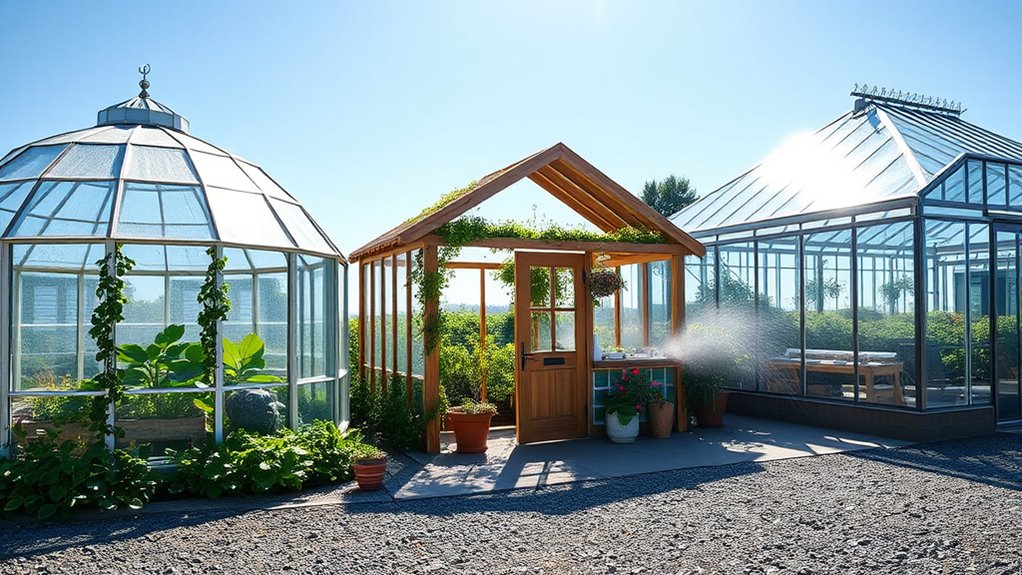
Specialty greenhouses cater to specific cultivation needs, offering tailored environments that enhance plant growth and yield.
If you’re interested in hydroponics, these greenhouses allow you to grow plants without soil, using nutrient-rich water solutions. This method can significantly improve investment returns on your agricultural efforts.
Educational greenhouses serve as learning tools in schools, while research greenhouses enable controlled scientific experiments.
For those focused on photoperiod control, light deprivation greenhouses maximize growth for crops like cannabis and chrysanthemums.
If you’re cultivating fruit trees, these structures maintain ideal temperature and humidity levels.
Each specialty greenhouse provides unique features and conditions, ensuring you create the perfect environment for your plants, no matter their needs. Additionally, incorporating color accuracy in your greenhouse setup can significantly impact the growth and health of your plants.
Consider which type aligns best with your cultivation goals for optimal outcomes.
Commercial Greenhouse Types and Their Uses
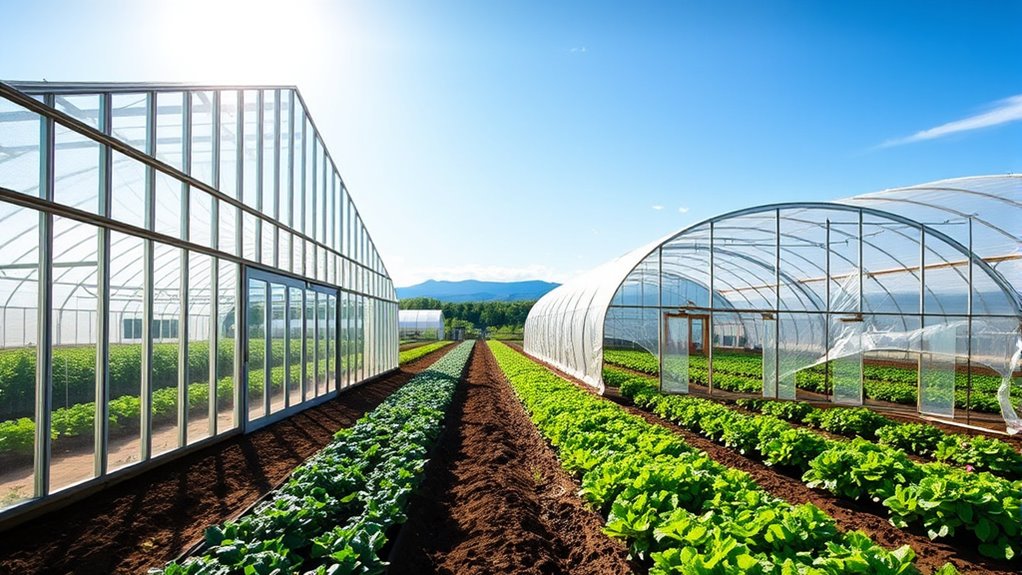
Commercial greenhouses come in various types, each designed to meet specific agricultural needs and enhance plant growth.
Depending on your focus, you might consider:
- Nursery Greenhouses: Perfect for starting seeds and nurturing young plants.
- Vegetable Greenhouses: Ideal for cultivating vegetables, extending growing seasons, and boosting yields.
- Floriculture Greenhouses: Specialized for growing flowers under favorable conditions.
- Fruit Tree Greenhouses: Designed to provide a controlled environment for fruit tree cultivation.
Each type serves a unique purpose, enabling you to maximize production and efficiency in your agricultural endeavors.
Key Considerations for Choosing Your Greenhouse
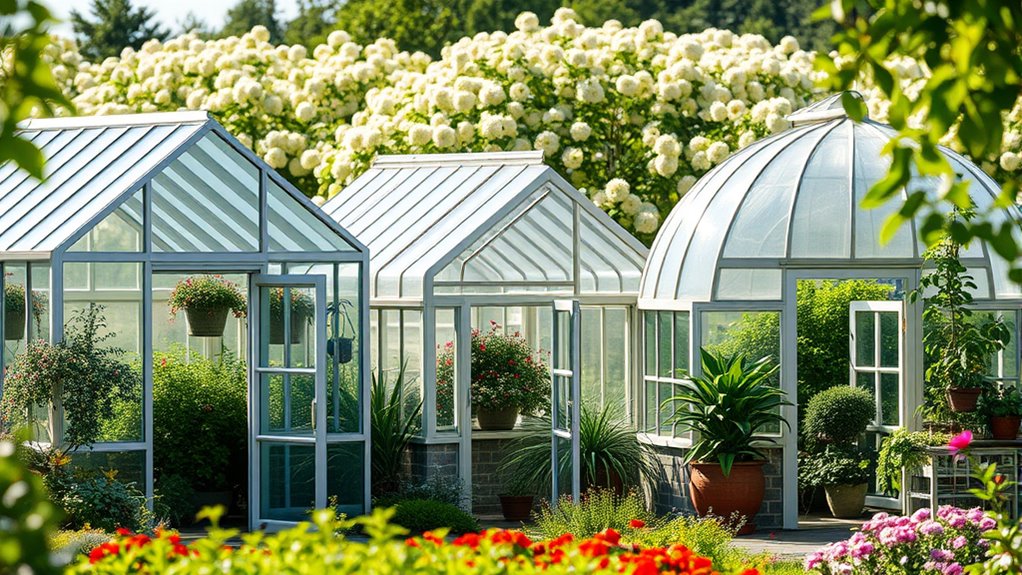
Choosing the right greenhouse for your needs is essential, as it directly impacts plant growth and production efficiency.
Start by considering your local climate; harsh winters demand sturdy frames and insulation, while hot areas benefit from good ventilation and shading.
Your choice of materials also plays a key role—glass offers durability but can be pricey, whereas polycarbonate is lightweight and energy-efficient.
Size matters too; small greenhouses work well for beginners, while larger options allow for more plants but require extra resources.
Budget considerations are vital; used or DIY greenhouses can save money.
Finally, think about customization options like automation and irrigation systems to enhance your greenhouse’s functionality and efficiency.
Frequently Asked Questions
How Do I Maintain Optimal Humidity Levels in My Greenhouse?
To maintain ideal humidity levels in your greenhouse, regularly monitor with a hygrometer.
Aim for around 80% humidity, adjusting as needed. Use ventilation systems to remove excess moisture, and consider dehumidifiers if it gets too high.
For low humidity, mist your plants or use humidifiers. Always keep an eye on your plants’ health, as they can indicate if adjustments are necessary.
Seasonal changes may also require you to tweak your humidity management strategies.
What Are the Best Plants for Beginners in a Greenhouse?
If you’re starting with a greenhouse, consider easy-to-grow vegetables like tomatoes, cucumbers, and zucchini.
These plants thrive with minimal care and provide quick results. For fruits, strawberries and microgreens are great choices, offering delicious rewards without much effort.
Don’t forget about herbs; basil and cilantro grow rapidly and enhance your cooking.
With these selections, you’ll enjoy a thriving greenhouse experience, making gardening enjoyable and rewarding right from the start.
How Can I Efficiently Heat My Greenhouse in Winter?
Imagine your greenhouse as a cozy cabin in winter’s embrace. To keep it warm, you can embrace both modern and natural methods.
Use electric or gas heaters for quick warmth, or harness the sun’s power with solar panels. Insulate with bubble wrap and place water barrels to store heat.
Don’t forget to choose cold-tolerant plants and circulate air with fans. These strategies’ll help you create a thriving, warm sanctuary during the cold months.
What Features Enhance Greenhouse Ventilation and Airflow?
To enhance ventilation and airflow in your greenhouse, consider using sidewall and ridge vents for natural airflow.
Utilize wind-driven ventilation to harness breezes, and orient your greenhouse to maximize sun exposure. Taller structures and roll-up sides can improve air exchange considerably.
For mechanical options, install fans or positive pressure systems to maintain consistent airflow. These features help control temperature and humidity, promoting healthier plants while reducing energy costs.
Can I Build a Greenhouse Myself, or Should I Hire a Professional?
You’re standing at a crossroads, wondering if you should tackle building a greenhouse yourself or hire a pro.
If you’re up for a challenge and have some basic skills, a DIY project can save you money and let you customize it to your needs.
However, if you’re short on time or want guaranteed quality, hiring a professional might be the better choice.
Consider your options carefully; the right decision can make all the difference!
Conclusion
In choosing the right greenhouse, consider your needs, budget, and the plants you want to grow. Whether you opt for a sleek glass structure or a more rustic hoop house, each type has its own charm and benefits. Just like a medieval knight picking the perfect armor for battle, selecting the right greenhouse will equip you for success in your gardening journey. Embrace the possibilities, and watch your green thumb flourish!




